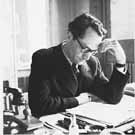
|
|
|

|

|

|

|
|
Click on an image to see a larger, more detailed picture.
|
|
|
|
|
| 1940: Machinery of Hatred |

|
pg. 200 |

|
|
|
|
| |
 None of the Dunski family pictured here survived the Holocaust. The oldest of four children, Zvi (seated by his mother, Fajga) was active in Ha-Shomer ha-Tsa'ir, a Zionist youth organization. He and his friends resisted the Nazis, publishing an underground newspaper and printing leaflets urging Jews of Sosnowiec, Poland, to flee deportation. Arrested by the Jewish police, Zvi was sent to the Gestapo prison in Katowice, Poland, where he was murdered. His mother and sister Sala (standing right) were sent to Auschwitz, where they perished, as did Genia (standing left). Only one child, Frania, imprisoned in various labor camps, survived the war.
None of the Dunski family pictured here survived the Holocaust. The oldest of four children, Zvi (seated by his mother, Fajga) was active in Ha-Shomer ha-Tsa'ir, a Zionist youth organization. He and his friends resisted the Nazis, publishing an underground newspaper and printing leaflets urging Jews of Sosnowiec, Poland, to flee deportation. Arrested by the Jewish police, Zvi was sent to the Gestapo prison in Katowice, Poland, where he was murdered. His mother and sister Sala (standing right) were sent to Auschwitz, where they perished, as did Genia (standing left). Only one child, Frania, imprisoned in various labor camps, survived the war.
Photo: Frania Dunska Friedman / United States Holocaust Memorial Museum Photo Archive
|
 Ion Antonescu, ruler of Romania from 1940 to '44, smiles warmly as he greets members of the Romanian High Command. After having obtained power with the support of the Iron Guard, Antonescu ordered the expulsion of Jews from villages and towns to urban centers. He also confiscated and nationalized Jewish property. Tried as a war criminal, Antonescu was executed on June 1, 1946.
Ion Antonescu, ruler of Romania from 1940 to '44, smiles warmly as he greets members of the Romanian High Command. After having obtained power with the support of the Iron Guard, Antonescu ordered the expulsion of Jews from villages and towns to urban centers. He also confiscated and nationalized Jewish property. Tried as a war criminal, Antonescu was executed on June 1, 1946.
Photo: National Archives / United States Holocaust Memorial Museum Photo Archive
|
 Rescue in France
Rescue in France
Although official policy of the United States government during 1940-41 closed gates to Jewish immigration, a handful of private, volunteer-staffed organizations launched rescue operations from America. The New York-based Emergency Rescue Committee (ERC) aided 2000 Jewish refugees--Spanish, German, and Czechoslovakian--who were stranded in France. ERC provided refugees with food, clothing, lodging, and medical care, and attempted to expedite their flight from France. The valiant efforts of Varian Fry (pictured), ERC's representative in Marseilles, France, made it possible for about 1000 Jews to escape. Among them were many of Europe's leading cultural figures, including artist Marc Chagall and writers Heinrich Mann and Walter Mehring. For one year, beginning in August 1940, Fry directed the covert escapes of hundreds of refugees. Frustrated by emigration restrictions, Fry set up clandestine operations complete with encrypted codes of communication and secret escape routes. He even established contacts with the underworld to obtain forged papers and boat passages. In one instance, more than 100 refugees--disguised as farm laborers--were smuggled across the French-Spanish border along unpatrolled paths. Sometimes, though, plans went awry, and French authorities apprehended ships and interned their passengers. Fry was himself expelled in August 1941.
|
|

|

|

|

|
 August 1940: 400 Jews sick with bleeding diarrhea at the Józefów, Poland, labor camp are executed.
August 1940: 400 Jews sick with bleeding diarrhea at the Józefów, Poland, labor camp are executed.
|
 August 9, 1940: Hitler orders Aufbau Ost, the buildup of military communications and transport in Poland, preparatory to a German invasion of the Soviet Union; See June 22, 1941.
August 9, 1940: Hitler orders Aufbau Ost, the buildup of military communications and transport in Poland, preparatory to a German invasion of the Soviet Union; See June 22, 1941.
|
 August 10, 1940: Romania passes antisemitic legislation.
August 10, 1940: Romania passes antisemitic legislation.
|
 August 15, 1940: Adolf Eichmann proposes turning the island of Madagascar into a huge Jewish ghetto, where Jews will die out.
August 15, 1940: Adolf Eichmann proposes turning the island of Madagascar into a huge Jewish ghetto, where Jews will die out.
|
|
|
|
|
| 1940: Machinery of Hatred |

|
pg. 200 |

|
|
The Holocaust Chronicle
© 2009 Publications International, Ltd.
|
|
